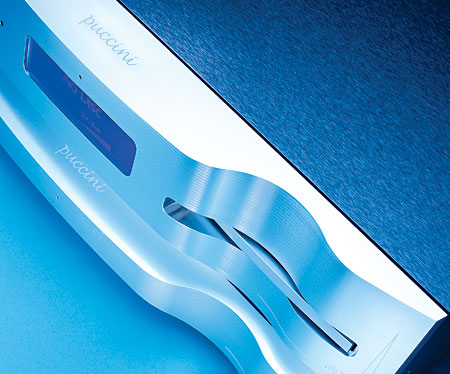| Columns Retired Columns & Blogs |
dCS Puccini SACD playback system Page 3
When the Puccini is clocked by the U-Clock, the former's display shows a pair of meshing gear wheels that solidify when lock is achieved. To decode USB-derived data, one of the U-Clock's S/PDIF outputs must be connected to the Puccini player's digital inputs. When you hook up the U-Clock to your computer, it identifies itself as "dCS Puccini Clock" and, somewhat confusingly, both sample-rate LEDs on the front panel illuminate.
The U-Clock will handle USB data with sample rates from 32 to 96kHz and bit depths up to 24. The U-Clock acts as a master clock when the Puccini is playing SACDs or CDs; when using one of its two S/PDIF inputs, the Puccini uses its phase-locked loop to clock the data. However, when it is receiving USB-derived data from the U-Clock, that input must be word-clock–synchronized to the U-Clock. It will still play music without word-clock lock, but I heard occasional plops as the source sample rate gradually drifted out of sync with the Puccini's own clock.
My only quibble with the U-Clock was that its four front-panel blue LEDs are very bright.
Sound
Before I did any serious auditioning, I updated the Puccini's firmware. (Shades of the Boulder disc player I reviewed in July, whose firmware I also had to update during the review—audio components are increasingly being transformed into application-specific computers!) The new software was provided on a CD-ROM, and the instructions on how to use the player's Menu buttons to load the new software from the disc were straightforward. Even so, I breathed a sigh of relief when the procedure had finished and the display showed me that the new versions were operational.

Despite the wide range of operational modes possible with the Puccini, I ended up using it to upsample CDs to DSD, and played both CDs and SACDs back with Filter 1, which offers the widest ultrasonic bandwidth. After some experimentation, I used the dither on the U-Clock, as I had with the original dCS Verona. And while the Puccini is definitely a top-rank player when used alone, the silences between the notes were blacker when clocked from the U-Clock, particularly with SACDs. Interestingly, with CDs I heard a greater difference when I removed the U-Clock from the system than when I inserted it, in that soundstages flattened a little and the musical flow became less expansive.
The thing that most struck me when I began auditioning the Puccini was that I could hear more reverberation and more spacious soundstages than I was used to, even from recordings that I had engineered, mixed, and mastered myself. On "Things I Didn't Know I Loved," Tim Takach's setting of the poem by Turkish poet Nazim Hikmet, the world-premiere recording of which appears on Cantus's 2008 release While You Are Alive (CD, Cantus CTS-1208), there was a slightly but significantly greater degree of space around the singers. In that respect, in fact, the CD sounded more like the hi-rez 24/88.2 master files. So I played those files back from my Mac mini via USB. Indeed, the difference between the CD's spatial representation and that of the master file was less than I remembered.
The same was true for my current recording project, pianist Robert Silverman performing Brahms' Handel Variations and Schumann's Symphonic études (scheduled for release in late spring 2010). I had recorded Robert in the same location, the Sauder Concert Hall at Goshen College, Indiana, where I had made the 2008 Cantus album, and with a very similar miking technique. I had wanted the piano to sound relatively close, but with enough of the hall's bloom surrounding its image to flesh out the presentation. With the master files played back via the U-Clock and Puccini, the reverberation sounded a little richer, and a little more coherent, than I had anticipated. And I couldn't hear a significant difference between the USB connection and the same files fed to the Puccini's S/PDIF input.
The Puccini's midrange clarity and definition were among the best I have experienced from digital. Even in half-century-old mono, Coleman Hawkins' tenor saxophone on The Hawk Flies High (SACD, Riverside/Mobile Fidelity Sound Lab UDSACD 2030) had a palpability and solidity that effortlessly drew me into the music. And with a 21st-century SACD—the often thrilling if always idiosyncratic performance of Bach's Brandenburg Concertos by Richard Egarr and the Academy of Ancient Music (Harmonia Mundi USA HMU807461.62)—the U-Clocked Puccini created a broad, expansive sweep of sound, with the sounds of the low-pitched instruments accurately presented.
I kept returning to piano recordings throughout my time with the Puccini. The dCS system loved the sound of this instrument, whether it was the horribly out-of-tune upright on David Ackles' classic "Down River," from his eponymous debut album (CD, Elektra), or the well-set-up Steinway D on my 1993 recording of Robert Silverman performing Liszt's monumental Sonata in b, on Sonata (CD, Stereophile STPH008-2)—which iTunes, in Shuffle mode, played in succession. Coincidentally, I was archiving the 20-bit master files for Sonata to DVD around the same time, so I played those through the Puccini via USB. Ahh. As proud as I am of the sound of the CD, the 20-bit files still had a touch more authority, and more image palpability.
- Log in or register to post comments




































